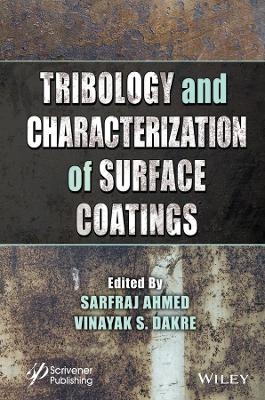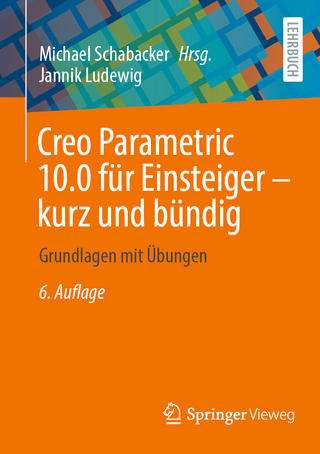
Tribology and Characterization of Surface Coatings
Wiley-Scrivener (Verlag)
978-1-119-81878-6 (ISBN)
Tribology and Characterization of Surface Coatings explores key issues which are important in the research and development of surface coatings by providing updated information on friction and wear behavior of coatings used in different industrial applications. It covers the various coating deposition techniques, tribological response of nanocomposite coatings, multilayer hardfacing, and wear testing methods for coatings at nanoscale. The use of nanostructures may alter the tribological, characterization, and mechanical properties of the materials. Thermal spraying is the most widely used technique in industry for the deposition of coatings and their tribological properties need to be determined. This book also includes the recent trends in biotribology and the materials used in implants to counter the abrasive wear.
Audience
The book will serve as a reference to researchers, scientists, academicians, industrial engineers, and students who work in the fields of materials/polymer science and mechanical engineering. Apart from their applications to aerospace and electronics industries, the coatings are also used in the field of biomedical engineering.
Sarfraj Ahmed is a Research Fellow at the National Institute of Technology, Raipur, India has more than 6 years of professional experience including industry and academia. He obtained his Master’s in Materials Engineering from VNIT, Nagpur in 2009 and his research areas are in tribology, coatings, and gas sensors. Vinayak S. Dakre obtained his PhD in metallurgical and materials engineering from Vivesvaraya National Institute of Technology (VNIT), Nagpur in 2019. He has published many research papers in international journals.
Preface xiii
1 Overview of Coating Deposition Techniques 1
Neeraj Mehta
1.1 Introduction 2
1.2 Thin-Film Characteristics 4
1.3 Techniques Based on Physical Deposition Processes 5
1.3.1 Evaporation 6
1.3.1.1 Mean-Free Path: A Significant Parameter for High-Quality Evaporation 8
1.3.2 Sputtering 9
1.3.2.1 Characteristics of Sputtering 12
1.3.2.2 Types of Magnetron Sputtering Technique 14
1.3.3 Other Techniques Based on Physical Deposition Processes 15
1.4 Techniques Based on Chemical Deposition Processes 18
1.4.1 Chemical Vapor Deposition (CVD) 18
1.4.1.1 Atmospheric Pressure Chemical Vapor Deposition (APCVD) 19
1.4.1.2 Low-Pressure Chemical Vapor Deposition (LPCVD) 20
1.4.1.3 Metal Organic Chemical Vapor Deposition (MOCVD) 21
1.4.1.4 Plasma Enhanced Chemical Vapor Deposition (PECVD) 23
1.4.1.5 Laser Chemical Vapor Deposition (LCVD) 23
1.4.2 Atomic Layer Deposition (ALD) 25
1.4.2.1 ALD Versus CVD Deposition Technique 27
1.4.3 Other Techniques Based on Chemical Deposition Processes 27
1.5 Present Status and Future Scope 29
1.6 Conclusion 30
References 30
2 Tribological Investigation of Developed Nanocomposite Mos2-Tio2-Zro2 Coating Material 33
Avinash V. Borgaonkar, Deepak Rai and Ismail Syed
2.1 Introduction 34
2.2 Materials and Methods 37
2.3 Experimental Details 40
2.4 Results and Discussions 41
2.5 Conclusions 45
References 45
3 Methods of Microstructural Characterization of Coatings 49
A. M. Kamalan Kirubaharan, D. Dinesh Kumar, K. Gobi Saravanan and Subhenjit Hazra
3.1 Introduction 49
3.2 X-Ray Diffraction 52
3.2.1 Coating Texture 54
3.2.2 Residual Stress Measurement 55
3.3 Atomic Force Microscopy 56
3.4 Scanning Electron Microscopy 57
3.5 Energy Dispersive X-Ray Spectroscopy 59
3.6 Transmission Electron Microscopy 60
3.7 X-Ray Photoelectron Spectroscopy 62
3.8 Electron Probe Microanalysis 63
3.9 Secondary Ion Mass Spectroscopy 64
3.10 Raman Spectroscopy 65
3.11 Conclusion 66
References 67
4 Wear Mechanisms and Methods of Wear Testing 71
Ahmed Abdelbary
4.1 Introduction 72
4.2 Mechanisms of Wear 72
4.2.1 Adhesion 72
4.2.2 Abrasion 74
4.2.3 Surface Fatigue 78
4.2.4 Corrosion 79
4.2.5 Erosion 80
4.2.6 Fretting 82
4.2.7 Impact 83
4.2.8 Thermal 84
4.3 Methods of Wear Testing 84
4.3.1 Sliding Wear Test 86
4.3.2 Rolling Wear Test 88
4.3.3 Scratch Wear Test 89
4.3.4 Abrasion Wear Test 90
4.3.5 Erosion Wear Test 92
4.3.6 Impact Wear Test 93
References 94
5 Mechanical Behavior of Thermal Spray Coatings 99
Jayant Gopal Thakare
5.1 Introduction 99
5.2 Elastic Modulus and Fracture Toughness 101
5.2.1 Effect of Microstructure on Fracture Toughness 108
5.3 Evaluation of Residual Stress 109
5.4 Conclusion 111
References 111
6 Tribological Properties of Carbon-Based Coatings 115
D. Dinesh Kumar, P. Kuppusami, Gobi Saravanan Kaliaraj, Siva Sankar Sana and A.M. Kamalan Kirubaharan
6.1 Introduction 116
6.1.1 Classification of Carbon-Based Coatings 116
6.1.1.1 DLC Coatings 117
6.1.1.2 Diamond Coatings 119
6.2 Deposition of Carbon-Based Coatings 120
6.2.1 Physical Vapor Deposition Techniques 121
6.2.2 Chemical Vapor Deposition Techniques 122
6.3 Tribo-Mechanical Characteristics of Carbon-Based Coatings 123
6.3.1 H-Free a-C or DLC Coatings 124
6.3.2 Hydrogenated a-C (H-DLC) Coatings 125
6.3.3 ta-C Coatings 126
6.3.4 Diamond Coatings: MCD, NCD, and UNCD 127
6.3.5 Metal-Doped Carbon-Based Coatings 129
6.4 Factors Influencing Tribological Properties of Carbon-Based Coatings 130
6.5 Conclusions 132
References 133
7 Performance Evaluation of Journal Bearing Under Thin-Film Lubrication 139
Sandeep Soni
7.1 Introduction 140
7.2 Governing Equations 141
7.2.1 Hydrodynamic Lubrication Modeling 141
7.2.2 Thin-Film Lubrication Modeling 143
7.3 Solution Strategy 144
7.4 Performance Characteristics 144
7.4.1 Load Carrying Capacity and Attitude Angle 145
7.4.2 Frictional Characteristics 145
7.4.3 Oil Flow Rate 146
7.4.4 Frictional Torque and Energy Loss 146
7.5 Results and Discussion 147
7.6 Conclusions 156
Nomenclature 157
Dimensionless Parameters 157
References 158
8 Bioactive Coatings for Biomedical Applications 159
Gobi Saravanan Kaliaraj, D. Dinesh Kumar and A.M. Kamalan Kirubaharan
8.1 Introduction 160
8.2 Surface Coating 161
8.3 Polyether Ether Ketone 163
8.4 Nitride Composites Coating 164
8.5 Binary Transition Metal Nitride Coatings 166
8.6 Hydroxyapatite-Based Coating 169
8.7 Bioactive Glass Coatings 171
8.8 Composite Coatings 172
8.9 Conclusions 174
References 174
9 Study of Tribological Behavior and Wear Mechanism of Nanocomposite Coatings 181
Lailesh Kumar, Pankaj Shrivastava, Deepankar Panda, Arka Ghosh and Syed Nasimul Alam
9.1 Introduction 182
9.1.1 Techniques Employed for Depositing Nanocoatings 187
9.1.1.1 Electrodeposition Coating 188
9.1.1.2 Plasma Detonation Technology 188
9.1.1.3 Vacuum Arc Deposition 189
9.1.1.4 Sol-Gel Technique 189
9.1.1.5 Cold Spray Method 189
9.1.1.6 Chemical Vapor Deposition 190
9.1.1.7 Physical Vapor Deposition 190
9.1.1.8 Thermal Spray Method 191
9.1.1.9 Solution Dispersion 191
9.1.1.10 Spray Coating 192
9.1.1.11 Dip Coating 192
9.2 Applications of the Different Nanocomposite Coating Techniques 193
9.2.1 The Future of Nanocoatings 194
9.3 Effect of Different Coating Techniques on the Mechanical Properties of the Materials 195
9.4 Corrosion Behavior in Nanocoatings 198
9.5 Wear Mechanism in Nanocoatings 200
References 205
10 Investigation of Automotive Disc Brake’s Material Based on Tribological Parameters by Using Computational Structural Analysis 211
Arul Prakash R., Vijayanandh R., Ramesh G., Hariaran S., Janardhanan Y., Senthil Kumar M. and Jagadeeshwaran P.
10.1 Disc Brake 212
10.1.1 Introduction 212
10.1.2 Materials Used in Disc Brakes 212
10.2 Literature Survey—Problem Description and Solution Technique 214
10.2.1 Problem Descriptions 214
10.2.2 Methodology Used—Computational Structural Analysis 215
10.3 Structural Analysis 215
10.3.1 Conceptual Design 215
10.3.2 Pre-Processing 216
10.3.3 Mathematical Modeling Used in this Finite Element Analysis 218
10.3.4 Generation of Grid and Its Convergence Study 220
10.3.5 Numerical Results on Disc 223
10.3.6 Comparative Analysis of Disc 226
10.3.7 Numerical Simulation on Brake Pad 226
10.3.8 Comparative Analysis of Brake Pad 231
10.4 Theoretical Investigations 231
10.4.1 Investigation- 1 232
10.4.2 Investigation- 2 233
10.4.3 Investigation- 3 234
10.5 Conclusion 235
References 235
11 Studies of Nanomechanical and Wear Testing Methods of Thermal Sprayed Coatings 239
Zulfequar Ali, Ashish Kumar Singh, Omprakash Thakare and Chitrakant Tiger
11.1 Introduction 240
11.2 Nanowear Testing Methods 240
11.2.1 Nanoscratch Testing 241
11.2.2 Nanofretting Wear Testing 242
11.3 Nanomechanical Testing Methods 242
11.3.1 Nanoindentation Technique 243
11.3.2 Nanoimpact Test 246
11.3.3 Micropillar Compression 246
11.4 An Overview of Past Research 246
11.5 Design of a New Coating 248
11.6 General Discussions 249
References 249
12 Overview of Biological Tissue Properties for Biotribology 253
L. DhiviyaLakshmi and V. Muthukumaran
12.1 Introduction 254
12.2 Tissue Interaction With Implant 255
12.2.1 Bone 257
12.2.2 Compact Bone 259
12.2.3 Trabecular Bone 260
12.2.4 Mechanical Property of Bone 260
12.3 Anisotropy 261
12.4 Heterogeneity 263
12.5 Aging 263
12.6 Hysteresis 264
12.7 Bone Remodeling 265
12.8 Joint 266
12.9 Biomechanics of Cartilage Degeneration 273
12.10 Biotribology of Total Hip Replacement (Metal-on-Metal Articulation) 274
12.11 Conclusion 278
References 278
13 Mechanical Behavior of Single and Multilayer Hardfacing on Ferrous Alloys 281
B. Venkatesh
13.1 Introduction 281
13.2 Experimental Details 282
13.2.1 Hardfacing Procedure 282
13.2.2 Characterization of the Stellite Hardfaced Surface 284
13.2.3 Erosion Investigation 284
13.2.4 Eroded Sample Characterization 285
13.3 Outcome 285
13.3.1 Hardfaced Layer Behavior 285
13.3.2 Rate of Erosion 287
13.3.3 Eroded Sample Inspection 290
13.4 Discussion 291
13.4.1 Literature Observations 291
13.4.2 Common Erosion Behavior 292
13.4.3 Deformation Depth 295
13.4.4 Efficiency of Erosion 297
13.4.4.1 Abrasive Wear 299
13.4.4.2 Sliding Wear 299
13.4.4.3 Erosive Wear 299
13.4.4.4 Microstructures for Fe-Cr Hardfaced Layers 303
13.5 Conclusions 303
References 303
Index 307
| Erscheinungsdatum | 10.03.2022 |
|---|---|
| Sprache | englisch |
| Maße | 10 x 10 mm |
| Gewicht | 454 g |
| Themenwelt | Technik ► Maschinenbau |
| ISBN-10 | 1-119-81878-8 / 1119818788 |
| ISBN-13 | 978-1-119-81878-6 / 9781119818786 |
| Zustand | Neuware |
| Haben Sie eine Frage zum Produkt? |
aus dem Bereich


